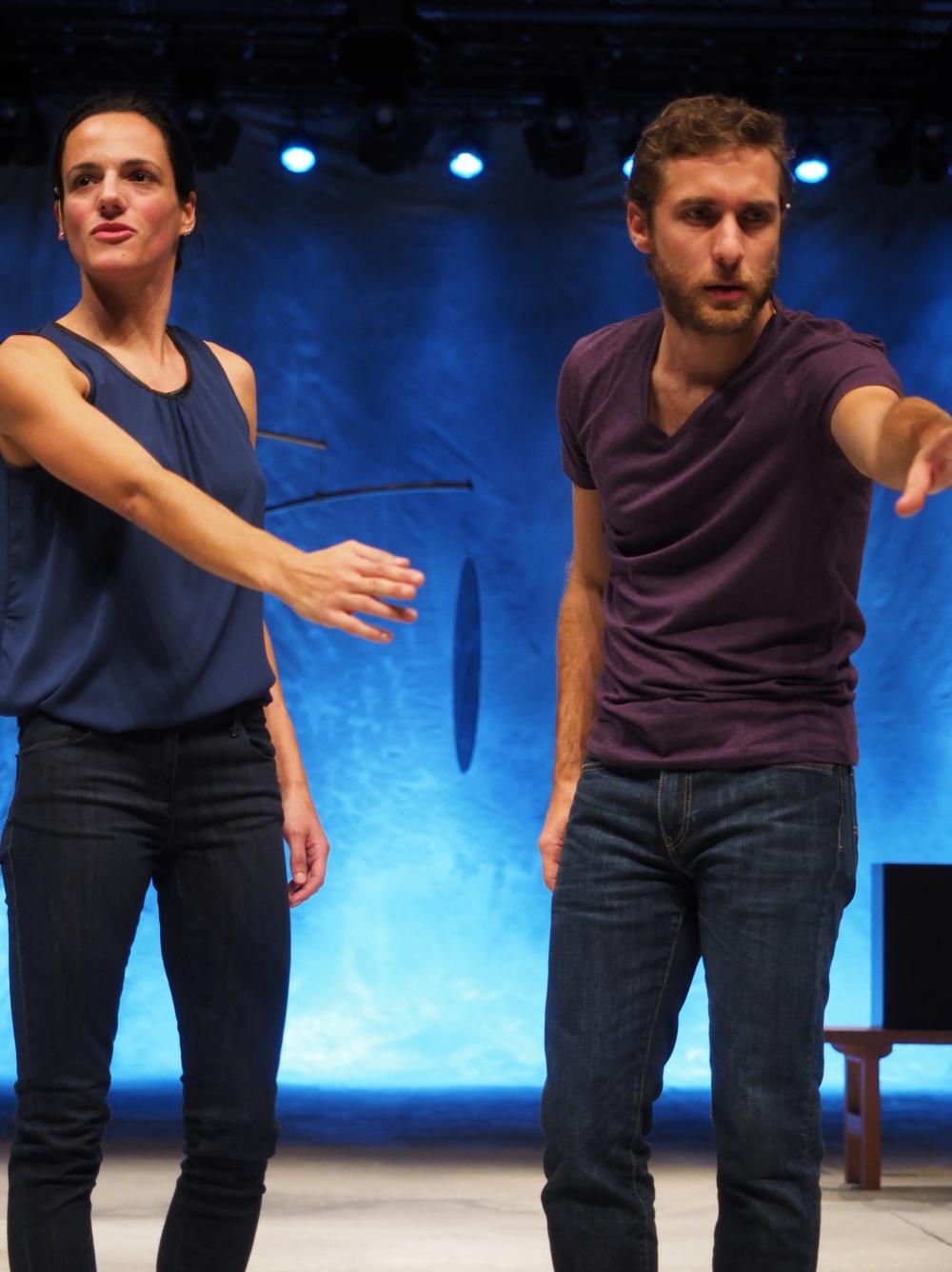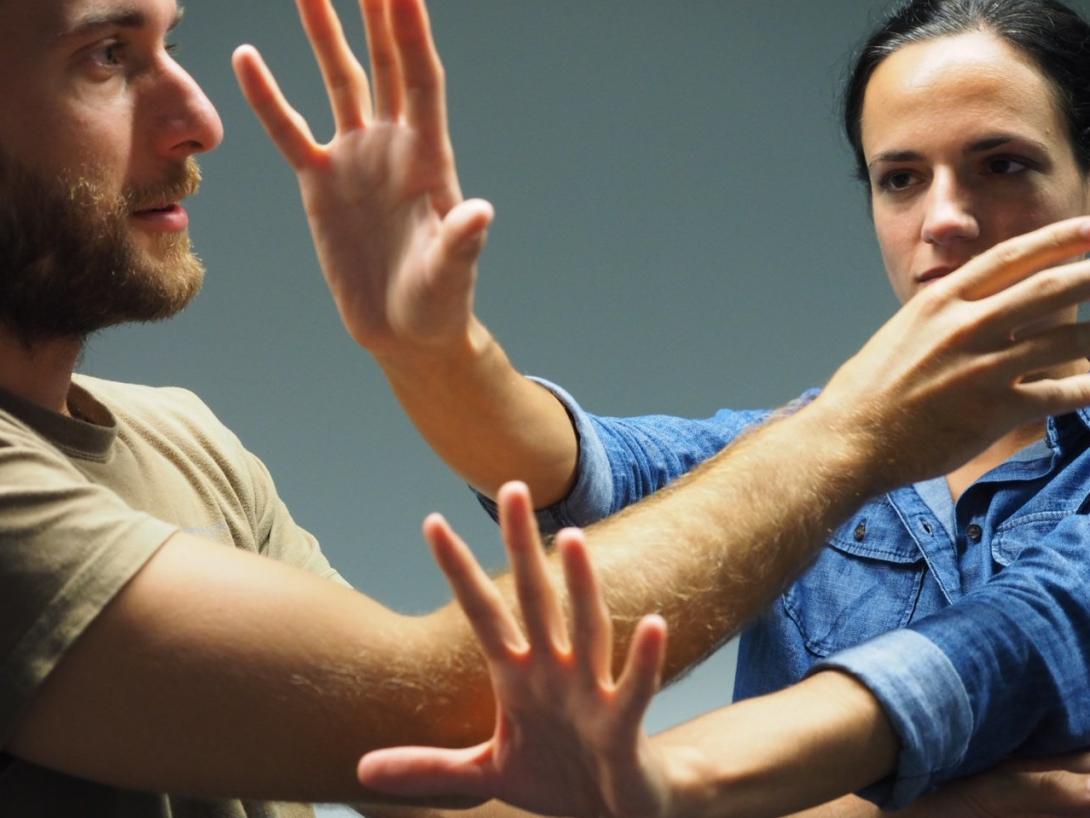A Collaboration of Love
Tiago Rodrigues on ‘Antony and Cleopatra'
The piece Anthony and Cleopatra that we created is not simply a rendition of William Shakespeare’s play. It is an original play that we built on the memory of Shakespeare’s tragedy. On a blurry line between plagiarism and quotation that would please Shakespeare, we accept that the transmission of a historical fact to a literary episode and a legend is marked by erosion.
Tiago Rodrigues on Antony and Cleopatra
"But the fortune of the day was still undecided, and the battle equal, when on a sudden Cleopatra’s sixty ships were seen hoisting sail and making out to sea in full flight, right through the ships that were engaged. For they were placed behind the great ships, which, in breaking through, they put into disorder. The enemy was astonished to see them sailing off with a fair wind towards Peloponnesus. Here it was Antony showed to all the world that he was no longer actuated by the thoughts and motives of a commander or a man, or indeed by his own judgment at all, and what was once said as a jest, that a soul of a lover lives in some one else’s body, he proved to be a serious truth. For, as if he had been born part of her, and must move with her wherever she went, as soon as he saw her ship sailing away, he abandoned all that were fighting and spending their lives for him, and put himself aboard a gallery of five ranks of oars, taking with him only Alexander of Syria and Scellias, to follow her that had so well begun his ruin and would hereafter accomplish it.” – Plutarch, Parallel Lives
The piece Anthony and Cleopatra that we created is not simply a rendition of William Shakespeare’s play. It is an original play that we built on the memory of Shakespeare’s tragedy, which in turn had its roots in the biographical portrait that the Greek philosopher Plutarch sketched of Mark Antony in Parallel Lives (1st/2nd century AD). He had himself inherited several writings and live accounts – Plutarch even cites his own great grandfather in the chapter about Mark Antony. We take on these and other legacies, less ancient but just as monumental. For example, we use fragments of music from the 1963 marathon film ‘Cleopatra’ directed by Joseph L. Mankiewicz, featuring the famous couple Elizabeth Taylor and Richard Burton. And we let ourselves get inspired by various paraphernalia resulting from the dazzling aura that Antony and Cleopatra’s romance still casts over historians, fictionists and audiences.
On a blurry line between plagiarism and quotation that would please Shakespeare, we accept that the transmission of a historical fact to a literary episode and a legend is marked by erosion. The erosion of time and language that dooms memory to incompleteness, and that, for that very reason, allows for interpretation and contribution. If we knew everything, we would know too much and be satisfied, therefore we wouldn’t feel the urge to make this show.
Shakespeare wrote an ‘Antony and Cleopatra’, presumably in 1606, which throughout time has not been appreciated as much as his other tragic works, such as Hamlet, Othello, King Lear or Macbeth. The work has been accused of a certain ‘imperfection’ or ‘canon transgression’ due to the multiplicity and dispersion of times and settings in its narrative, in clear disobedience to the Aristotelian parameters. Shakespeare scholar John Drakakis described the specific literary style of the work as “deconstruction avant la lettre” originated by a language that appears to come from a “stream of consciousness”. In the readings we did of the original Shakespeare play, during the first rehearsals for our project, it was precisely this transgressive spirit in the play’s structure that pushed us to take the necessary freedom and ‘irresponsibility’ in order to dare to create our own ‘Antony and Cleopatra’.
The specificity of Shakespeare’s tragedy lies in the fact that it is an inventory of dichotomies: east and west; reason and feeling; masculine and feminine; politics and sex; war and love; work and leisure; tragedy and comedy. Face to face, side by side, in complementarity or symbiosis, each ingredient in this play always finds its match or its reverse, much like the titular pair of the work.
Fascinated by the idea of the pair, we downsized Shakespeare’s pharaonic cast to two performers: the dancer/couple Sofia Dias and Vítor Roriz. On stage, they are more themselves than they are a representation of Cleopatra and Antony. As performers, they actively engage with their role, with their own ‘character’ in relation to the other. Sofia talks obsessively of an Antony and Vítor talks with equal persistence about a Cleopatra. Sofia is always describing what an Antony, who lives in an imaginary staging, does and says, and vice-versa. “Always vice-versa”, we say in the synopsis of the show. Indeed, vice-versa could have been a title for this piece.
So we tried to invent a pair that speaks of another pair, continually reciting and evoking the invisible Antony and Cleopatra shifting between historical spectres and fictions, to the point of merging momentarily with these names, giving them a visible form. We feed the identity confusion between Antony and Cleopatra, but also between performers and characters. We propose the entanglement that a pair is always about. That’s the idea that Plutarch himself proposes when, in the passage describing the way Antony flees the battle to pursue Cleopatra, he writes in a jocular but understanding tone that “the soul of a lover always lives in someone else’s body.”
This idea from Plutarch, which speaks of an Antony disconnecting himself from his identity, destroying his reputation and honour to see the world through Cleopatra’s eyes, is as much a love thesis as a theatrical paradox. It is exactly the ‘soul in someone else’s body’ that we aim for when the pair Sofia and Vítor try to see the world through Antony and Cleopatra’s eyes, but also through each other’s eyes. It is the ‘soul in someone else’s body’ that we speak of when we invent a play for a pair of choreographers.
Much like the confusion of a pair that switches bodies, we wanted to create a show in which the theatrical writing and staging would understand the world vicariously: essential to achieving this is the mathematical, playful and strictly poetic language of Sofia Dias and Vítor Roriz’s choreographic universe. Our ‘Antony and Cleopatra’ was composed imagining theatre through their eyes. Their performances are committed to being on stage, using a body of text and theatre that is foreign to them, though at the same time also familiar. It is important to say that ‘foreign’ does not imply distance. On the contrary, this collaboration is born out of the recognition that there is an artistic affinity with the foreign body. That although it belongs to somebody else we could picture it as our own. And when switching bodies, we don’t hopelessly lose ours. We lend it temporarily. Those lent bodies can be translated literally into a collaboration, into working together.
Angela Rocha’s set design and the lighting by Nuno Meira, governed by an idea of instability and perpetual movement, shape the apparently rule-free playing field where this artistic collaboration takes place, inspired by the atmosphere of a collaboration of love. We also collaborate with history, with Plutarch, with Shakespeare. And finally we collaborate with the audience, that indispensable and ultimate collaborator. That foreign body we want our lover’s soul to inhabit.

